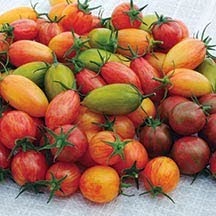Over the last few weeks I have been gradually planting what I consider to be the "main attraction" in my garden: the tomatoes. All the tomato lovers out there will know what I mean.
Each year I look forward to starting the plants from seed, nursing them along until they reach garden size, and ultimately transplanting them into the garden. It's fun to chose the varieties you like and to experiment with different ones, especially now in the age of heirloom tomatoes.
Planting tomatoes is a fairly simple process, now that the soil has been prepared for some time now. One of the most important factors to consider when planting tomatoes is temperature. After many years of experience, I have learned not to plant them too early in the season. It is better to wait a few weeks to ensure that the weather will remain consistently warm for the season. Here in central NY State, it is best to wait until late May or early June.
The first step is to dig small holes about six inches deep in which to place the plants. My plants are currently in 3 inch peat pots, so the hole should be large enough to accommodate those, and deep enough to provide enough support to the stems. This year I am placing composted manure in the holes to mix with the soil.
 |
| Preparing to Plant Tomatoes |
 |
| Mixing in Composted Manure |
Next, simply place the tomato plant in the hole. I normally peel off the bottom of the peat pot to make it easier for the roots to grow. This step isn't necessary as the roots will grow through the peat pot as it decomposes in the soil.
Make sure to fill in enough dirt around the plants to ensure adequate support of the stems. Also be sure to water them to ease the shock of transplanting.
To provide additional support, I use tomato cages that support the plants as they grow. Proper support is especially important as the pants develop tomatoes. They become heavy and will topple if not supported. The tomato cages are fairly inexpensive and can be use for many seasons.
 |
| Placing Tomato Cages |
Another step that I add to ensure that the plants are protected is placing wood shingles around them. This is an old school technique that provides both shading and wind protection for the new transplants. I typically will remove these after a couple of weeks. I first talked about using the wood shingles in my post on May 10, 2014 (http://dansgardening.blogspot.com/2014/05/planting-more-early-season.html).
 |
| Wood Shingle Protection |
The final step is to add grass clippings or some form of mulch around the plants. This step is optional of course, but I find it cuts down tremendously on the weeding and also keeps the ground moist throughout the summer.
 |
| The Tomatoes Are Planted! |
By now you are probably wondering which tomato varieties I transplanted. The varieties I started this year from seed were detailed in my posts on March 25, 2014 (http://dansgardening.blogspot.com/2014/03/its-tomato-starting-time.html) and April 7, 2014 (http://dansgardening.blogspot.com/2014/04/planting-more-tomatoes-more-heirlooms.html).
The actual varieties that I have transplanted thus far are:
Artisan from the Jung Seed Company:
 |
| Artisan Tomaoes |
Unique Appearance - Exceptional Flavor
Whether you're a master chef or a home cook, you'll love all the options these tomatoes bring to the table. The breeders of Artisan's focused on combining excellent flavor with unique colors and shapes. The results are these beautiful and tasty, round and elongated, striped and blushed cherry-type fruits that range from 1.5 to 2 inches in size, resist cracking and keep well. Indeterminate plants stay healthy and extremely productive over an extended period.
Grappoli Carbarino, an Italian bunching and paste tomato:
 |
| Grappoli Carbarino |
Heirloom Rainbow Blend, from Park Seeds:
 |
| Contains Aunt Ruby's German Green, Dixie Golden Giant, Black from Tula, Brandywine Red, Big Rainbow, and Cherokee Purple. |
Cherokee Purple:
Big Rainbow:
If I find room in the garden I may try to squeeze a few more plants in! However, I'm rapidly running out of gardening space as is usually the case every year.
Finally, as promised, a photo of a Killdeer that I spotted on the lawn last weekend. These are interesting birds, a member of the plover family. They are know for there signature run-stop, run-stop behavior as they try to stir up bugs to eat as they run. We usually have a pair every summer.
 |
| Killdeer |
Until next time. Thanks for reading.




No comments:
Post a Comment